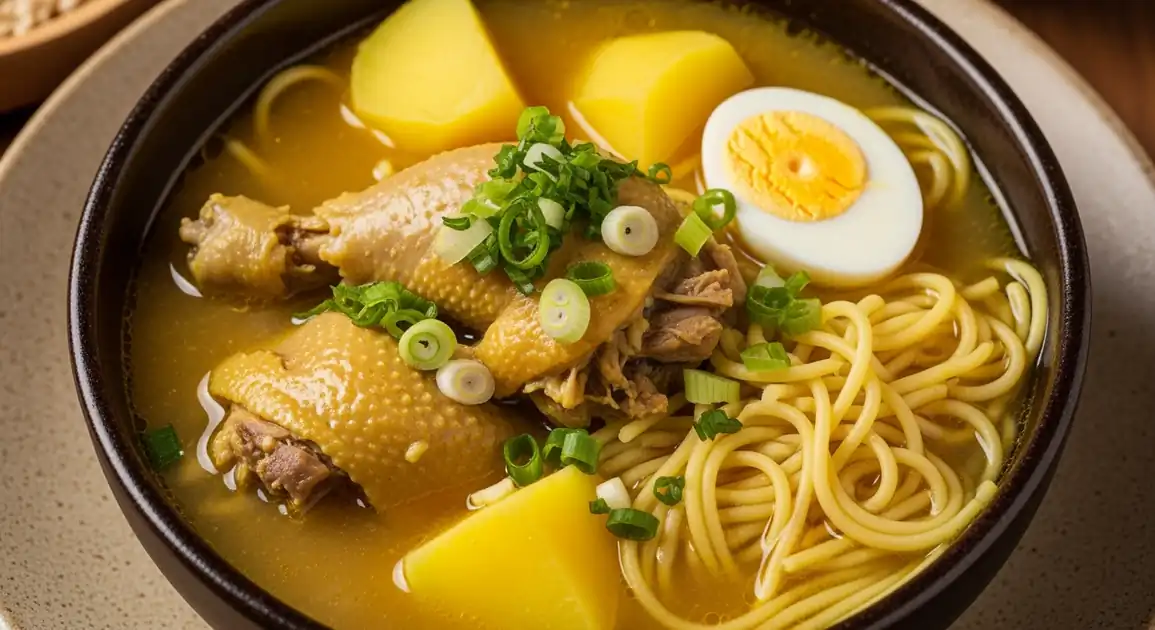Caldo de Gallina (Hen Broth)
Caldo de Gallina

Description
Caldo de Gallina is a beloved national comfort food found across Peru, from bustling Lima markets to high Andean towns. It's particularly cherished as a restorative breakfast, a hearty lunch, or a late-night 'levantamuertos' (hangover cure). While available everywhere, regional nuances in preparation might exist.
Dietary Information
Serving information
Serving style
Served piping hot in a large, deep bowl. Accompanied by lime wedges, chopped scallions, cancha serrana, and ají (chili sauce) for diners to add to taste.
Quick facts
Market stalls: Early morning (from 5 AM/6 AM) to mid-afternoon. Restaurants: Lunch & Dinner. Late-night spots: 9 PM onwards, sometimes until dawn.
Safety Tips
What to Look For
-
Soup served steaming hot
Ensures the soup is at a safe temperature (above 60°C / 140°F), minimizing bacterial risk. Visible steam is a good sign.
-
Busy vendor with high turnover
Indicates the soup is frequently replenished and likely kept consistently hot. Popular stalls often maintain quality.
-
Clean serving area, bowls, and utensils
Basic hygiene is crucial. Look for clean ladles, bowls washed properly, and vendors handling food cleanly.
-
Fresh-looking toppings
Garnishes like scallions should look fresh and green, not wilted. Cancha should be crisp.
-
Clear, rich broth (not murky or separated weirdly)
While rich yellow, the broth should look appetizing and well-emulsified, not like old soup with odd textures.
What to avoid
-
Soup that is lukewarm or cold
This is the danger zone for bacterial growth. Never consume lukewarm Caldo de Gallina.
-
Dirty stall, visibly unclean bowls or utensils
Increases the risk of contamination significantly.
-
Pre-cooked ingredients (potato, egg, noodles) sitting out uncovered for long periods
These should be added fresh or kept properly heated/chilled and covered.
-
Vendors with poor personal hygiene (dirty hands)
Direct handling of food requires clean hands or utensils.
-
Soup with an 'off' smell or taste
Trust your senses. If it smells sour (beyond lime addition) or unpleasant, do not eat it.
Price information
Price range
Budget tips
- Markets offer the most affordable prices (8-15 PEN).
- Local eateries ('huariques') are also budget-friendly.
- Restaurants in tourist areas or upscale establishments will charge more (15-25+ PEN).
- Portion sizes are usually generous, offering good value.
Value indicators
- Deep, rich yellow broth flavour.
- Tender hen meat (not dry).
- Served steaming hot.
- Generous portion of noodles, potato, and egg.
- Fresh toppings available.
Where to Find This Dish
Central Markets ('Mercados Centrales')
Most cities have central markets with dedicated soup stalls.
Mercado Central (Lima), Mercado San Pedro (Cusco), Mercado San Camilo (Arequipa)
Morning
Dedicated 'Calderías' or 'Caldúdromos'
Eateries or market sections specializing only in soups.
Specific streets known for soups (e.g., parts of La Victoria in Lima)
Morning, Lunch, Late Night
Traditional Criollo Restaurants
Restaurants focusing on classic Peruvian home-style cooking.
Various locations nationwide
Lunch, Dinner
Vendor Tips
- Look for large, simmering pots – a sign of traditional preparation.
- Observe where locals are eating; queues often indicate quality.
- Don't be shy about adding toppings generously.
How to Order
Regional Variations
-
Standard Caldo de Gallina
(Caldo de Gallina Clásico)
The typical preparation with hen broth, hen meat, noodles (fideos), potato (papa amarilla), and hard-boiled egg (huevo duro).
-
Caldo de Gallina with Rice
(Caldo de Gallina con Arroz)
Less common, but some versions might substitute rice for noodles.
-
Caldo de Gallina 'Especial'
(Caldo de Gallina Especial)
Often implies a larger portion, potentially with extra meat, egg, or other additions depending on the vendor.
-
Caldo Blanco (Similar Base)
(Caldo Blanco)
A related Andean soup, often simpler, sometimes with lamb or beef instead of hen, different herbs, but shares the hearty broth concept.
Cultural context
History
Rooted in Peruvian home cooking and the tradition of using older, flavourful hens, Caldo de Gallina evolved into a popular dish served in markets and simple eateries ('huariques'). Its reputation as a restorative meal, particularly effective as a breakfast boost or a late-night hangover cure ('levantamuertos'), cemented its place in urban food culture across Peru, from the coast to the Andes.
Local significance
Represents hearty, unpretentious, nourishing food. Deeply ingrained as a restorative soup, believed to cure hangovers, colds, and general fatigue. A taste of home for many Peruvians.
Eating customs
- Adding lime, ají, cancha, and cebolla china is standard practice.
- Eaten hot and often quickly.
- Considered a complete meal in itself.